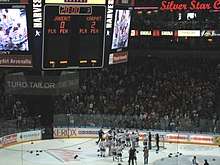Oulu
Oulu (/ˈoʊluː/ OH-loo,[7][8] Finnish: [ˈou̯lu] (![]()
![]()
Oulu Uleåborg | |
|---|---|
City | |
| Oulun kaupunki Uleåborgs stad | |
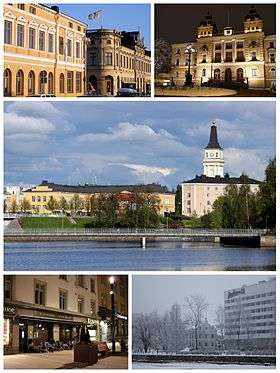 Top: Rantakatu in downtown Oulu, Oulu City Hall Middle: Lyseo Upper Secondary School and the Oulu Cathedral Bottom: Shops along Kirkkokatu, Radisson Blu Hotel along Ojakatu | |
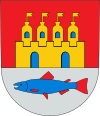 Coat of arms | |
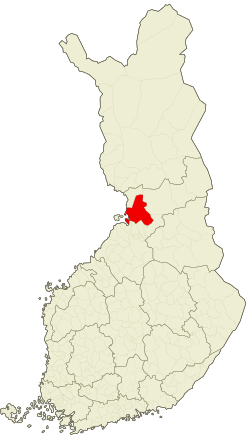 Location of Oulu in Finland | |
| Coordinates: 65°00′51″N 25°28′19″E | |
| Country | |
| Region | |
| Sub-region | Oulu sub-region |
| Charter | 1605-04-08 |
| Government | |
| • City manager | Päivi Laajala |
| Area (2018-01-01)[1] | |
| • City | 3,817.52 km2 (1,473.95 sq mi) |
| • Land | 1,410.17 km2 (544.47 sq mi) |
| • Water | 103.2 km2 (39.8 sq mi) |
| • Urban | 187.1 km2 (72.2 sq mi) |
| Area rank | 17th largest in Finland |
| Population (2019-01-31)[2] | |
| • City | 203,750 |
| • Rank | 5th largest in Finland |
| • Density | 144.49/km2 (374.2/sq mi) |
| • Urban | 208 939[3] |
| • Urban density | 915.8/km2 (2,372/sq mi) |
| Population by native language | |
| • Finnish | 97.3% (official) |
| • Swedish | 0.2% |
| • Others | 2.4% |
| Population by age | |
| • 0 to 14 | 17% |
| • 15 to 64 | 70.5% |
| • 65 or older | 12.5% |
| Time zone | UTC+02:00 (EET) |
| • Summer (DST) | UTC+03:00 (EEST) |
| Municipal tax rate[6] | 19% |
| Website | www.ouka.fi/oulu/english/ www.visitoulu.fi/en/ |
Oulu is considered one of Europe's "living labs", where residents experiment with new technology (such as NFC tags and ubi-screens) on a community-wide scale.[9]
Etymology
The city is named after the river Oulujoki, which originates in the lake Oulujärvi. There have been a number of other theories for the origin of the name Oulu. One possible source is a word in the Sami language meaning 'flood water', but there are other suggestions. At minimum, the structure of the word requires that, if originally given by speakers of a Uralic language, the name must be a derivative. In all likelihood, it also predates Finnish settlement and is thus a loanword from one of the now-extinct Saami languages once spoken in the area.
The most probable theory is that the name derives from the Finnish dialectal word oulu, meaning "floodwater", which is related to e.g. Southern Sami åulo, meaning "melted snow", åulot meaning "thaw" (of unknown ultimate origin). Two other word families have also been speculated to be related. The first is seen in the Northern Savo dialectal word uula and its Sami counterpart oalli, both meaning "river channel". The second is the Uralic root reconstructed as *uwa, meaning "river bed" (reflected as vuo in modern Finnish, also in derivatives such as vuolas "heavy-flowing"). To either of these roots, some Sami variety would have to be assumed having added further derivational suffixes.[10]
History
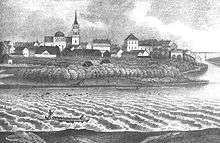
Oulu is situated by the Gulf of Bothnia, at the mouth of river Oulujoki, which is an ancient trading site. The city proper was founded on 8 April 1605 by King Charles IX of Sweden, opposite the fort built on the island of Linnansaari. This took place after favourable peace settlements with Russia, which removed the threat of attack via the main east-west waterway, the river Oulu. The surrounding areas were populated much earlier. Oulu was the capital of the Province of Oulu from 1776 to 2009.
In 1822, a major fire destroyed much of the city. The architect Carl Ludvig Engel, chiefly known for the neoclassical (empire style) buildings around Helsinki Senate Square, was enlisted to provide the plan for its rebuilding. With minor changes, this plan remains the basis for the layout of Oulu's town center. The Oulu Cathedral was built in 1832 to his designs, with the spire being finished in 1844. During the Crimean War, Oulu's harbour was raided by the British fleet, who destroyed ships and burned tar houses, leading to international criticism.
Once known for wood tar and salmon, Oulu has evolved into a major high-tech centre, particularly in IT and wellness technology. Other prominent industries include wood refining, chemicals, pharmaceuticals, paper, and steel.
The municipality of Ylikiiminki was merged with the city of Oulu on 1 January 2009. Oulu and the municipalities of Haukipudas, Kiiminki, Oulunsalo, and Yli-Ii were merged on 1 January 2013.[11]
Oulu was the site of the 2018 Oulu child sexual exploitation scandal. Prime Minister Juha Sipilä declared that “Sex crimes against children are inhumane acts of incomprehensible evil.”[12]
Geography
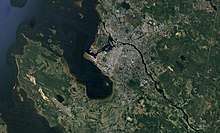
Oulu is located in northern Finland, a considerable distance from the other cities in the country. Mainland Finland's northernmost and southernmost points are roughly equidistant from Oulu. Oulu's coast sits at the Bothnian Bay (Perämeri in Finnish) and the Swedish mainland is about 180 km directly west across the Bothnian Bay. The nearby island Hailuoto is just off the coast.
Subdivisions
Oulu is divided into 106 city districts. The largest of these are Haukipudas, Oulunsalo, Kaakkuri, Ritaharju, Tuira, and Kello.
Climate
Oulu has a subarctic continental climate (Köppen: Dfc). It is the largest Finnish city entirely in this climatic zone as well as one of the largest such in the world. The typical features are cold and snowy winters with short and warm summers.[13][14] Average annual temperature is 2.7 °C (36.9 °F). The average annual precipitation is 477 mm (18.78 in) falling 105 days per year, mostly in late summer and fall. The warmest temperature ever recorded in Oulu was 33.3 °C (91.9 °F) in July 1957,[15] while the coldest temperature on record was −41.5 °C (−42.7 °F) in February 1966.[16]
| Climate data for Oulu, 1981-2010 normals, records 1921 - present | |||||||||||||
|---|---|---|---|---|---|---|---|---|---|---|---|---|---|
| Month | Jan | Feb | Mar | Apr | May | Jun | Jul | Aug | Sep | Oct | Nov | Dec | Year |
| Record high °C (°F) | 9.3 (48.7) |
7.8 (46.0) |
11.5 (52.7) |
23.9 (75.0) |
29.9 (85.8) |
32.3 (90.1) |
33.3 (91.9) |
30.5 (86.9) |
25.4 (77.7) |
20.5 (68.9) |
11.2 (52.2) |
8.2 (46.8) |
33.3 (91.9) |
| Average high °C (°F) | −6 (21) |
−5.7 (21.7) |
−0.9 (30.4) |
5.6 (42.1) |
12.5 (54.5) |
17.9 (64.2) |
20.9 (69.6) |
18.3 (64.9) |
12.5 (54.5) |
5.8 (42.4) |
−0.4 (31.3) |
−4 (25) |
6.4 (43.5) |
| Daily mean °C (°F) | −9.6 (14.7) |
−9.3 (15.3) |
−4.8 (23.4) |
1.4 (34.5) |
7.8 (46.0) |
13.5 (56.3) |
16.5 (61.7) |
14.1 (57.4) |
8.9 (48.0) |
3.3 (37.9) |
−2.8 (27.0) |
−7.1 (19.2) |
2.7 (36.8) |
| Average low °C (°F) | −13.6 (7.5) |
−13.3 (8.1) |
−8.8 (16.2) |
−2.6 (27.3) |
3.3 (37.9) |
9.0 (48.2) |
12.2 (54.0) |
10.1 (50.2) |
5.4 (41.7) |
0.8 (33.4) |
−5.5 (22.1) |
−10.8 (12.6) |
−1.2 (29.9) |
| Record low °C (°F) | −37.5 (−35.5) |
−41.5 (−42.7) |
−32 (−26) |
−21.4 (−6.5) |
−9.1 (15.6) |
−6.1 (21.0) |
3.6 (38.5) |
−1.5 (29.3) |
−8 (18) |
−20.6 (−5.1) |
−33 (−27) |
−37.2 (−35.0) |
−41.5 (−42.7) |
| Average precipitation mm (inches) | 31 (1.2) |
26 (1.0) |
26 (1.0) |
20 (0.8) |
37 (1.5) |
46 (1.8) |
71 (2.8) |
65 (2.6) |
44 (1.7) |
45 (1.8) |
36 (1.4) |
30 (1.2) |
477 (18.8) |
| Average precipitation days | 10 | 8 | 8 | 6 | 7 | 7 | 9 | 10 | 9 | 10 | 11 | 10 | 105 |
| Average relative humidity (%) (daily average) | 87 | 86 | 82 | 73 | 67 | 66 | 71 | 76 | 82 | 86 | 90 | 89 | 80 |
| Mean monthly sunshine hours | 24 | 69 | 137 | 208 | 273 | 296 | 283 | 212 | 133 | 69 | 28 | 8 | 1,740 |
| Source 1: FMI[17] | |||||||||||||
| Source 2: FMI (record highs and lows 1961- present)[18] | |||||||||||||
Demographics
| Significant foreign resident groups[20] | |
|---|---|
| Nationality | Population (2018) |
| 1,899 | |
| 1,221 | |
| 681 | |
| 487 | |
| 475 | |
| 424 | |
| 326 | |
| 236 | |
| 235 | |
| 222 | |
In 2008, there were 316 Swedish speaking inhabitants, which was 0.2% of the total population, making the city unilingual. In 2007, there were 2,417 foreign citizens living in the city, of whom 618 were from elsewhere in the EU. 51.1% of the population is female.
Population
Culture
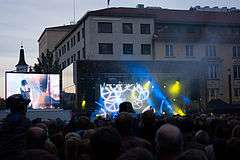
The best known cultural exports of the city of Oulu are the Air Guitar World Championships held annually in August, Mieskuoro Huutajat (also known as Screaming Men), the now defunct metal band Sentenced, and one of the best ice hockey teams in Europe, Oulun Kärpät.
Many artists, writers, and musicians live in the city. A variety of concerts — rock, classical, and jazz — as well as other cultural events take place each year. Examples include the Oulu Music Video Festival, the Air Guitar World Championships, and the Musixine Music Film Competition, all in August. In July, the annual rock festival Qstock takes place. The Oulu Music Festival is held in winter and the Oulunsalo Music Festival in summer. The Irish Festival of Oulu takes place each October, and the International Children's Film Festival each November.
Museums in Oulu include the Northern Ostrobothnia museum, the Oulu Museum of Art (OMA), the Tietomaa science center, and the Turkansaari open-air museum.
Notable statues and sculptures in Oulu include a sculpture of Frans Michael Franzén and The Bobby at the Market Place statue.
Kalmah is a melodic death metal-band from Oulu that formed in 1998.
Sights
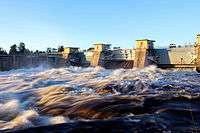
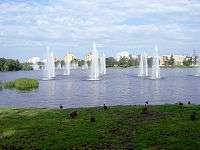
- Rotuaari pedestrian zone
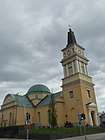
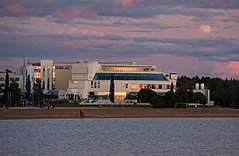 Spa Hotel Eden and sand beach in Nallikari recreation and tourism area.
Spa Hotel Eden and sand beach in Nallikari recreation and tourism area.- Mannerheim Park is a favourite hangout place for many.
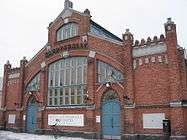
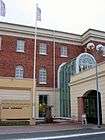
- The old observatory in Linnansaari. It was built in 1875 on top of the ruins of the Castle of Oulu.
- Snowy bicycles in front of library of architecture of Oulu University.
- The church of the Holy Family of Nazareth Parish in Oulu, built by the Neocatechumenal Way. February 2006
- Tietomaa, a science center with over 150 exhibits
- The Rapids Center, the area in the estuary of the Oulu river consisting of small islands connected with bridges and fountains in the middle of the river, and including a housing area of building blocks planned by Alvar Aalto
- The Market Square with the City Library, the City Theatre and old salt and tar storehouses
- Hupisaaret Islands, a large park area located in the estuary of the Oulu river
- The F. M. Franzen memorial
- The Koitelinkoski rapids
- The Northern Ostrobothnia museum
- The Pateniemi Sawmill Museum
- The Vehicle Museum
- The University of Oulu Botanical Gardens (situated in Linnanmaa)
- The Arctic Gallery
- Technopolis, the technology village
- Turkansaari (historical open-air museum)
Churches
- Cathedral
- Haukipudas Church
- Holy Family of Nazareth Church
- Holy Trinity Cathedral of Oulu
- Kiiminki Church
- Oulujoki Church
- Oulunsalo Church
- St. Luke's Chapel
- Tuira Church
- Ylikiiminki Church
Other points of interest
- Oulu Music Video Festival
- Air Guitar World Championships
- Jalometalli Metal Music Festival
- The Irish Festival of Oulu
- Laitakari beacon tower
- Madetoja Hall, housing the Oulu Music Centre (website) the residence of the Oulu Symphony Orchestra
- Oulu Hall (a large indoor sports facility consisting of a low dome, which looks somewhat like a landed flying saucer)
- Terwa Marathon & Run event in late May (since 1989)
- The Terva-skiing event in early March (since 1889)
- The Winter Swimming World Championship
Education
The University of Oulu and Oulu University of Applied Sciences have their main campuses located in Oulu.
Oulu is home to the most northerly architecture school in the world. The school is best known for its strong regionalistic ideas for developing architecture. This movement is named "the Oulu school" ("Oulun koulu") of architecture.
Oulu Vocational College has over 13 000 students. It houses several different study subjects in different units which are spread over Oulu and neighbouring municipalities. Oulu Vocational College School of Business Studies is one of the few vocational schools which has game programming in its curriculum.
Oulu International School is one of nine schools in Finland offering basic education in English.
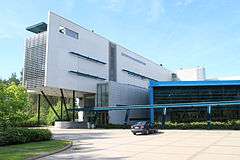 University of Oulu main building. |
Transport
Oulu is served by Oulu Airport, the second largest airport in Finland by passenger volume. It is located 15 kilometres (9 mi) south-west of the city centre.
The Port of Oulu is one of the busiest harbours on the Bothnian Bay. It includes four separate harbour areas: Vihreäsaari oil and bulk docks, Nuottasaari docks and Oritkari docks.
The shortest travel time from Oulu railway station to Helsinki Central railway station is 5 h 29 min, operated by VR. Other destinations include Kolari, Rovaniemi, Seinäjoki and Tampere.
The most important road in Oulu is Highway 4 (E8/E75) that runs from Helsinki to Utsjoki via Lahti, Jyväskylä, Oulu, Kemi and Rovaniemi. Other highways running to and from Oulu are Highway 20 to Kuusamo and Highway 22 to Kajaani.[22]
Oulu is notable for its transportation network dedicated to non-vehicular traffic, including pedestrians and bicycles (termed "light" traffic in Finland). In 2010, the city contained more than 600 kilometres (370 mi) of pathways and more than 100 underpasses and bridges devoted exclusively to light traffic. The network is used year-round. The ratio of light traffic pathways to residents is the highest in Finland and the cycling mode share is 20 percent.[23][24] Oulu is often touted as an excellent city for bicycling.
In 2015, a large underground parking facility, Kivisydän (Stone Heart), opened in the city center directly beneath main shopping streets. The network of parallel roads for cars and pedestrians was drilled in the rock at the depth of 30 meters. The parking facility includes two ramps, 900 visitor parking lots (expandable to 1500), six access points to the ground served by 19 elevators (expandable to nine and 25), a service facility for commercial delivery vehicles, and ubi-screens that guide the driver to the selected ground access point and help locate the parked car by its license number.[25][26]
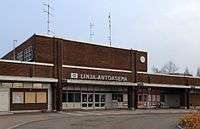 Oulu Bus Station
Oulu Bus Station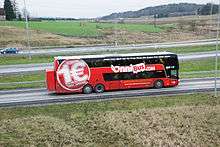 OnniBus is one of the bus companies that operate from the bus station
OnniBus is one of the bus companies that operate from the bus station
- Ahmosuo Airfield is a General aviation hub in Oulu
- VR Group operates railway traffic through the Oulu railway station
 Atlantic coast container ship at the Port of Oulu
Atlantic coast container ship at the Port of Oulu Kivisydän underground car park and Air raid shelter
Kivisydän underground car park and Air raid shelter Oulu public transport buses have pink colored fronts
Oulu public transport buses have pink colored fronts
Solar power
In 2015, the Kaleva Media printing plant in Oulu became the most powerful photovoltaic solar plant in Finland, with 1,604 solar photovoltaic (PV) units on its roof. Although the city of Oulu, located near the Arctic Circle, has only two hours of weak sunlight in December, the photovoltaic cells work almost around the clock in the summer. The cold climate means the PV panels can get up to a 25% boost per hour, as they don't overheat.[27]
Because the sun is quite low in the sky at this latitude, vertical PV installations are popular on the sides of buildings. These solar walls also capture light reflected from snow.[27]
Snow is not necessarily cleared from rooftop solar installations.[27]
The local utility, Oulun Energia, is owned by the city of Oulu. The energy mix it receives from the Nordic-wide grid includes wood pellets, waste incineration, bioenergy, hydro-electric, geothermal, wind, nuclear, peat, natural gas and coal.[27]
Employment
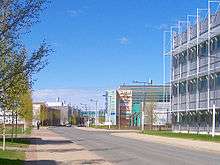
As of 31 December 2008, the active working population was employed as follows:[28]
| Industries | Working population |
|---|---|
| Services | 43,049 |
| Industry | 11,111 |
| Commerce | 10,848 |
| Construction | 5,449 |
| Transport | 3,698 |
| Farming, forestry and mining | 582 |
| Unknown | 431 |
| Unemployment rate | 16.3% (2016) |
| Total | 75,158 |
In 2011, the most important employers were:[28]
| Employer | No. of employees |
|---|---|
| City of Oulu | 9,709 |
| Northern Ostrobothnia Hospital District | 6,144 |
| University of Oulu | 3,045 |
| Nokia Networks | 2,100 |
| Nokia Group | 2,000 |
| The Oulu Region Joint Authority for Vocational Training | 1,955 |
| Kesko Group | 1,426 |
| Cooperative Arina Group (S Group) | 1,107 |
| Stora Enso Group | 1,155 |
| Itella Corporation | 780 |
| ISS Palvelut Oy | 730 |
| ODL Group | 653 |
Sports
Ice hockey is the most popular spectator sport in Oulu. The local club Kärpät has won the SM-liiga championship title eight times (1981, 2004, 2005, 2007, 2008, 2014, 2015 and 2018). It has also twice been the runner-up in the IIHF European Champions Cup, in 2005 and in 2006.
In football AC Oulu plays in Ykkönen, the second tier of the Finnish league system. So far OPS has claimed the Finnish football championship only twice by winning Mestaruussarja in 1979 and in 1980. Other notable football clubs include OLS, OTP and JS Hercules.
Oulu has one well-known bandy club, OLS, which plays in Bandyliiga and has become Finnish champions 14 times, most recently in 2014. The other bandy club, OPS, with its 7 championships and a bronze medal as late as in 2009, announced it would be closing down after the 2009-10 season. In 2001 the city was the main venue for the Bandy World Championship.
Oulu is also home to several other sports clubs such as Oulu Northern Lights (American football), Oulun NMKY (Basketball), Oulun Lippo (Pesäpallo), Oulun Pyrintö (Track and field), SK Pohjantähti (Orienteering)), OYUS (Rugby union), Oulu Irish Elks (Gaelic football) and ETTA (Volleyball).
Oulun Tervahiihto is an annual ski marathon event held since 1889.
Terwa Run & Marathon is an annual running event held since 1989 in late May.
Notable people from Oulu
- Saara Aalto, singer, X Factor UK finalist
- Peter von Bagh, film historian and director
- Vladislav Delay, electronic musician
- Lars Gallenius, 17th century painter
- Matti Hautamäki, ski jumper
- Aaro Hellaakoski, poet
- V.A. Koskenniemi, poet
- Leevi Madetoja, composer
- Frans Michael Franzén, poet
- Impaled Nazarene, nuclear metal band
- Iivo Niskanen, Olympic champion cross-country skier
- Kerttu Niskanen, cross-country skier
- Leena Peltonen-Palotie, geneticist
- Susanna Pöykiö, figure skater
- Mika Ronkainen, filmmaker
- Keke Rosberg, 1982 Formula One world champion
- Kauko Röyhkä, author and rock musician
- Sara Wacklin, teacher and writer
- Mikael Toppelius, church painter
- Three former Presidents of the country, Kaarlo Juho Ståhlberg, Kyösti Kallio and Martti Ahtisaari, also a Nobel Peace Prize laureate
- Ice Hockey players, Kari Jalonen, Mikael Granlund, Markus Granlund, Joni Pitkänen, Reijo Ruotsalainen, Mika Pyörälä, Lasse Kukkonen, Sebastian Aho
- Football players, Aki Lahtinen, Seppo Pyykkö, Antti Niemi and Mika Nurmela
International relations
Twin towns and sister cities
Oulu is twinned with:[29]
|
|
Partnership and twinning cities
In addition Oulu has eight 'Partnership & Twinning cities':[34]
International municipal projects
The educational department was apart of the Lifelong Learning Programme 2007–2013 in Finland.
See also
References
- "Area of Finnish Municipalities 1.1.2018" (PDF). National Land Survey of Finland. Retrieved 30 January 2018.
- "Suomen virallinen tilasto (SVT): Väestön ennakkotilasto [verkkojulkaisu]. Tammikuu 2019" (in Finnish). Statistics Finland. Retrieved 15 March 2019.
- Tarkoma, Jari (2008-01-15). "Taajamissa asuu 84 prosenttia väestöstä". Tiedote (in Finnish). Statistics Finland (Tilastokeskus). Retrieved 11 February 2013.
- "Population according to language and the number of foreigners and land area km2 by area as of 31 December 2008". Statistics Finland's PX-Web databases. Statistics Finland. Retrieved 29 March 2009.
- "Population according to age and gender by area as of 31 December 2008". Statistics Finland's PX-Web databases. Statistics Finland. Retrieved 28 April 2009.
- "List of municipal and parish tax rates in 2011". Tax Administration of Finland. 29 November 2010. Retrieved 13 March 2011.
- "Oulu". The American Heritage Dictionary of the English Language (5th ed.). Boston: Houghton Mifflin Harcourt. Retrieved 10 May 2019.
- "Oulu". Merriam-Webster Dictionary. Retrieved 10 May 2019.
- Saylor, Michael (2012). The Mobile Wave: How Mobile Intelligence Will Change Everything. Perseus Books/Vanguard Press. p. 63.
- "Oulu-nimen etymologia". Scripta.kotus.fi. Retrieved 2011-09-16.
- "Uusi Oulu" [New Oulu] (in Finnish). Oulu: City of Oulu. 9 September 2011. Retrieved 19 September 2011.
- Aleksi Teivainen (6 December 2018). "Police: 10 people suspected of sex crimes against minors in Oulu". Helsinki Times. Retrieved 31 January 2019.
Prime Minister Juha Sipilä (Centre) on Wednesday issued an official statement on the much-discussed case, saying the events have shocked many, for a good reason. “Sex crimes against children are inhumane acts of incomprehensible evil,” he stated
- "Oulu, Finland Köppen Climate Classification (Weatherbase)". Weatherbase. Retrieved 2019-03-03.
- Learning, Innovative Language; FinnishPod101.com. Learn Finnish - Level 5: Advanced: Volume 1: Lessons 1-25 (in Finnish). Innovative Language Learning.
- Ilmatieteellinen Keskuslaitos: Suomen meteorologinen vuosikirja, osa 1a 1957.
- Ilmatieteellinen Keskuslaitos:Suomen meteorologinen vuosikirja, osa 1a 1966.
- "FMI normals 1981-2010" (PDF). FMI. Retrieved 26 April 2016.
- "FMI open data". FMI. Retrieved 7 September 2019.
- http://pxnet2.stat.fi/PXWeb/pxweb/fi/StatFin/StatFin__vrm__vaerak/statfin_vaerak_pxt_032.px/table/tableViewLayout2/?rxid=726cd24d-d0f1-416a-8eec-7ce9b82fd5a4%5B%5D
- "Väestö kielen mukaan sekä ulkomaan kansalaisten määrä ja maa-pinta-ala alueittain 1980–2012" (in Finnish). Tilastokeskus. 22 April 2013. Retrieved 1 April 2013.
- Autoilijan Tiekartta 2007 – Road map (Map). 1:800,000. AffectoGenimap Finland Oy. 2006. ISBN 978-951-593-047-7.
- Jeffrey Pratte, "Mainstreaming Bicycling in Winter Cities: The case of Oulu, Finland", Masters thesis, University of Manitoba (Canada), 2011. P. 99-100
- Anders Swanson, "Winter Cycling for Everyone", (Video, 21:30 min.), Vimeo, 2013
- "Archived copy". Archived from the original on 2016-03-10. Retrieved 2016-03-09.CS1 maint: archived copy as title (link)
- "Kivisydän parking facility in Oulu". Oulunliikekeskus.fi. Archived from the original on 2016-03-10. Retrieved 24 December 2017.
- Hockenos, Paul (2020-02-24). "Solar Power Just Miles from the Arctic Circle? In Icy Nordic Climes, It's Become the Norm". InsideClimate News. Retrieved 2020-02-26.
- "Business and industry" (PDF). Information about Oulu. Oulu: City of Oulu. 2012-01-01. Retrieved 27 June 2012.
- "Ystävyyskaupungit (Twin Cities)". Oulun kaupunki (City of Oulu) (in Finnish). Retrieved 2013-07-27.
- "Vennskapsbyer" (in Norwegian). Alta kommune.
- Информация о городах-побратимах. Arhcity.ru (in Russian). October 26, 2007. Retrieved 27 July 2013.
- "Kardeş Şehirler". Bursa Büyükşehir Belediyesi Basın Koordinasyon Merkez. Tüm Hakları Saklıdır. Retrieved 2013-07-27.
- "Astana and Finnish Oulu become twin-cities". Tengrinews.kz. Retrieved 24 December 2017.
- "Partneri- ja kummikaupungit (Partnership and twinning cities)". Oulun kaupunki (City of Oulu) (in Finnish). Retrieved 2013-07-27.
External links
| Wikimedia Commons has media related to: |
- Official website

- Visitoulu.fi – VisitOulu.fi – Official tourism website of Oulu

